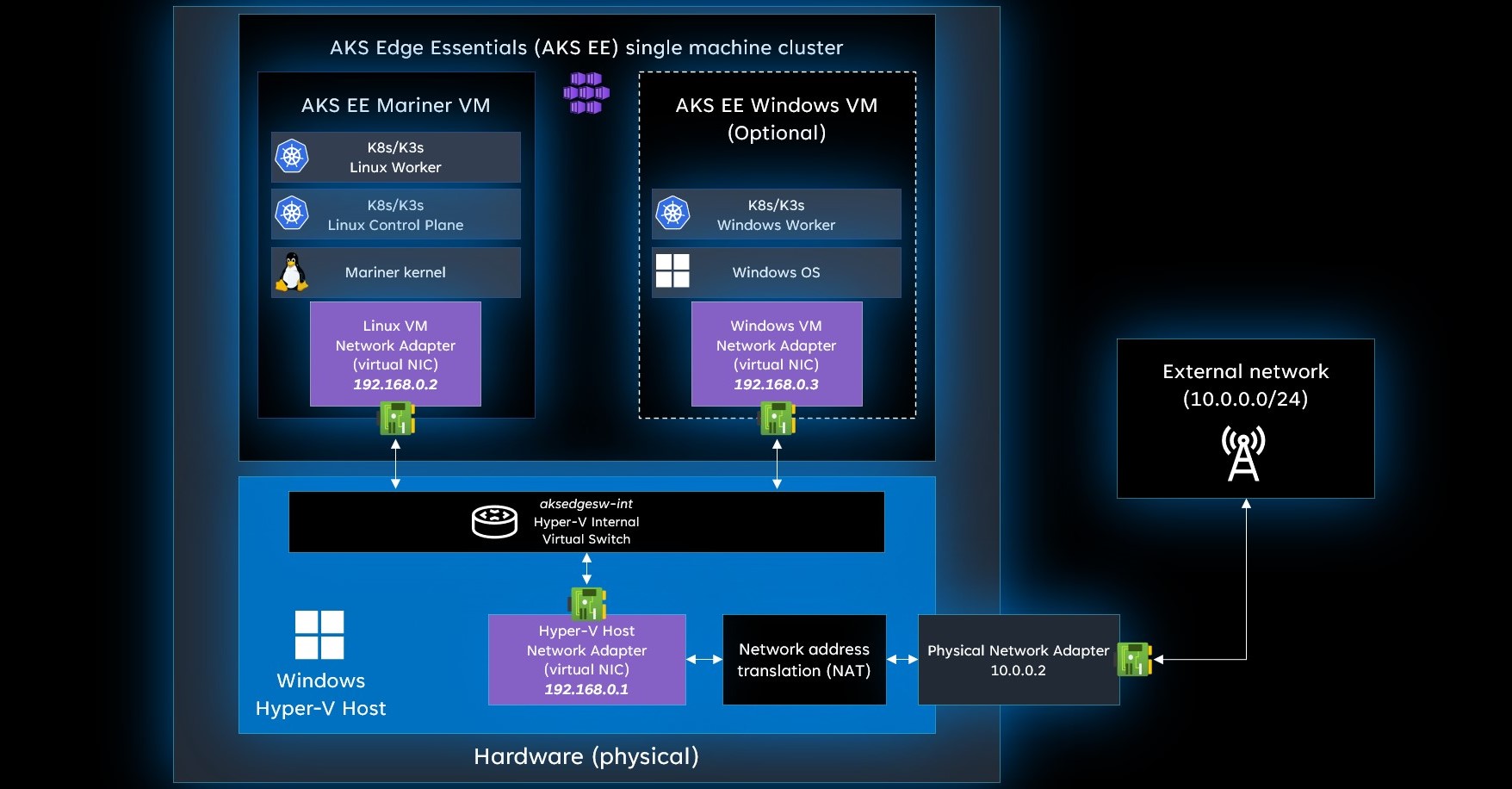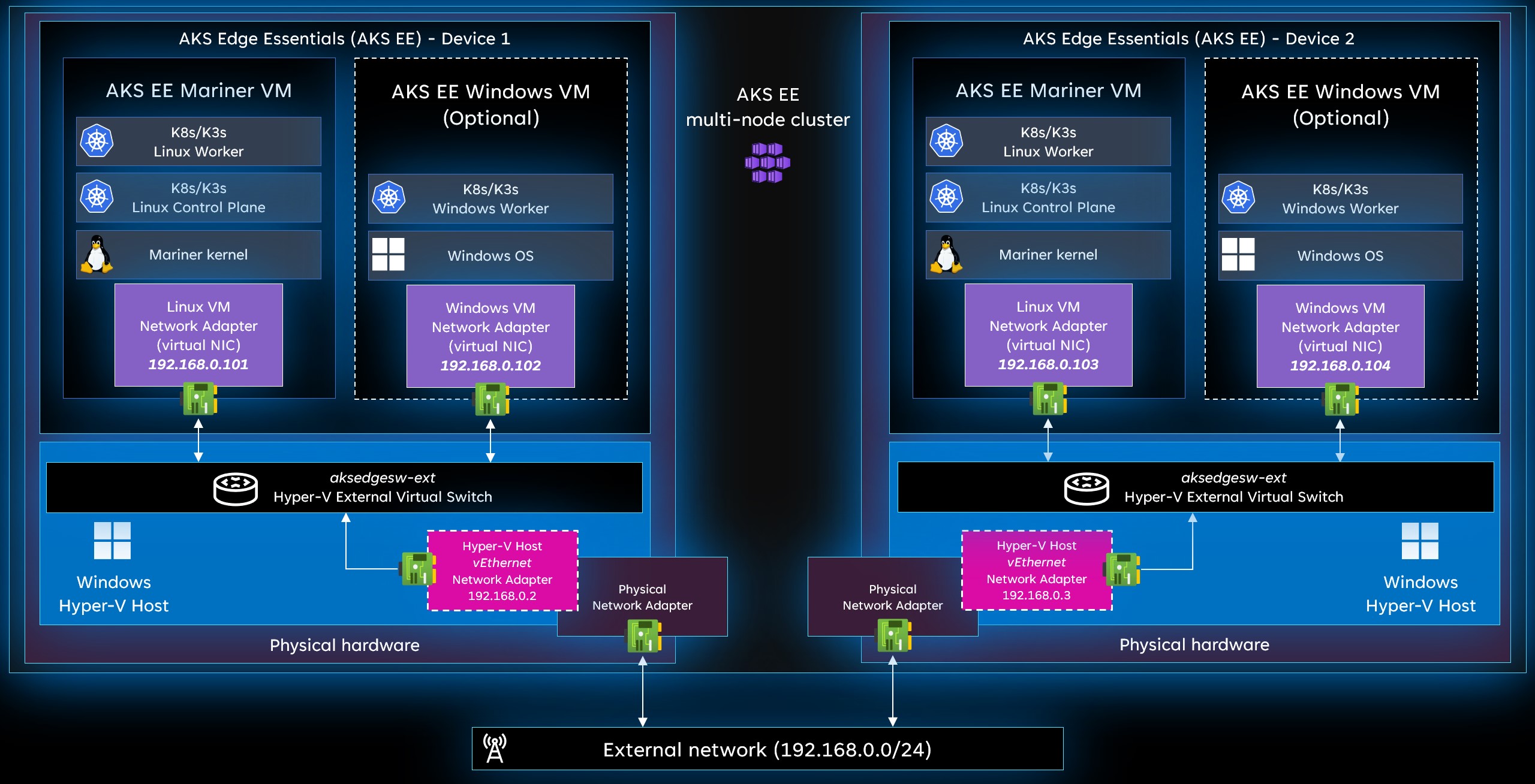AKS Edge Essentials networking
This article describes how to configure the networking between the Windows host OS and the Linux and Windows nodes' virtual machines. For more information about AKS Edge Essentials architecture, see the AKS Edge Essentials overview.
Tip
The following guide describes different networking concepts and configurations available in AKS Edge Essentials. If you use a single machine cluster, the installer and deployment mechanism handle all the necessary networking configuration. No extra steps or configuration are needed to deploy your cluster.
Networking
This guide assumes that you have control over your network and router (that is, in a home setting). If you are in a corporate environment, we recommend you ask your network administrator for a range of free IP addresses (from the same subnet) that are reachable on the internet.
To establish a communication channel between the Windows host OS and the Linux and Windows virtual machines, we use a Hyper-V networking stack. For more information about Hyper-V networking, see Hyper-V networking basics.
The following key networking concepts for AKS Edge Essentials align with Kubernetes concepts:
- Virtual switch: Hyper-V component that allows virtual machines created on Hyper-V hosts to communicate with other computers. For more information, see Create and configure a virtual switch with Hyper-V. AKS Edge Essentials supports two types of virtual switches:
- Internal: Connects to a network that can be used only by the virtual machines running on the Windows host OS that has the virtual switch, and between the host OS and the virtual machines.
- External: Connects to a wired, physical network by binding to a physical network adapter. It gives virtual machines access to a physical network to communicate with devices on an external network. In addition, it enables virtual machines on the same Hyper-V server to communicate with each other.
- Control plane endpoint IP address: The Kubernetes control plane is reachable from this IP address. You must provide a single IP that is free throughout the lifetime of the cluster for the Kubernetes control plane.
- Service IP addresses range: The Service IP range is a pool of reserved IP addresses used for allocating IP addresses to the Kubernetes services (your Kubernetes services/workloads), for your applications to be reachable.
- Virtual machine IP address: In AKS Edge Essentials, Kubernetes nodes are deployed as specialized virtual machines, which need IP addresses. You must assign free IPs to these VMs.
Networking by deployment type
If AKS Edge Essentials is deployed using a single machine cluster or a scalable cluster, we support different types of switches, IP address assignation, and configurations, as shown in the following table.
| Single machine cluster | Scalable cluster | |
|---|---|---|
| Type of virtual switch | Internal | External |
| Virtual switch creation | Automatic | Manually by user or automatically based on physical net adapter name. |
| IP address assignment | Automatic – Addresses defined | Static IP addresses configured by user. |
| Outbound connections | Using virtual switch | Directly using the physical net adapter. |
| Inbound connections | Not reachable | Using the virtual machine IP address. |
| DNS | Configurable using the DnsServers parameter – if not provided, use Windows host DNS servers. |
Configurable using DnsServers parameter – if not provided, use Windows host DNS servers. |
| Proxy | Configurable using the http_proxy, https_proxy and no_proxy parameters. |
Configurable using http_proxy, https_proxy and no_proxy parameters. |
| Offline deployment | Supported using the InternetDisabled parameter. |
Supported using the InternetDisabled parameter. |
| Service IP range | If the ServiceIPRangeSize parameter is defined, starts at 192.168.0.4. |
Both the ServiceIPRangeStart and ServiceIPRangeSize parameters can be defined. |
| Static MAC Address | Supported using the MacAddress parameter. |
Supported using the MacAddress parameter. |
| Maximum transmission unit (MTU) | Supported using the MTU parameter. |
Supported using the MTU parameter. |
Important
The Kubernetes pod cidr is 10.42.0.0/16 for K3s and 10.244.0.0/24 for K8s. The Kubernetes service cidr is 10.43.0.0/16 for K3s and 10.96.0.0/12 for K8s.
Single machine cluster
Single machine deployments use an internal virtual switch to manage the networking. This type of deployment must have a Linux node; a Windows node is optional. The following diagram shows a single machine deployment architecture using internal virtual switch:
During single machine deployment, AKS Edge Essentials creates an internal virtual switch named aksedgesw-int, as well as the appropriate virtual network adapters to connect the virtual machines and the Windows host OS. The setup also handles the IP address assignment and address translation for the NICs. For example, IP addresses of the virtual NICs could be defined as follows:
- Windows host OS: 192.168.0.1
- Linux node virtual machine: 192.168.0.2
- Windows node virtual machine: 192.168.0.3
- Service IP addresses start: 192.168.0.4
The 192.168.0.0/24 address family can change depending on the internal virtual switch; however, nodes and host OS will always have the same suffix: host OS (.1), Linux VM (.2), Windows VM (.3) and ServiceIP start (.4).
Finally, by using address translation, traffic is able to reach the external network using the physical network adapter. The previous diagram shows an external network using the 10.0.0.0/24 IP address family, but this depends on the networking environment in which the device is installed.
Scalable cluster
In scalable cluster deployments, the nodes running inside the different devices must communicate between each other. Therefore, all nodes must be connected to the same network. To achieve this node-to-node communication across devices, AKS Edge Essentials scalable cluster deployments use external virtual switches. The following diagram shows a multi-machine deployment architecture using an external virtual switch:
To start this type of deployment, you must provide the following networking parameters during deployment:
- AdapterName: Name of the physical adapter connected to the external network. You can run the PowerShell
Get-NetAdapter -Physicalcommand to view theNamecolumn for the adapter of your choice. - Ip4Address: Specify the IP address your VM takes. Each node needs its own unique IP address.
Once deployment is finished, all nodes and the Windows host OS will be connected to the external network using the same external virtual switch. Because nodes are connected directly to the network, there's no need for address translation. The previous diagram shows a networking architecture using the 192.168.0.0/24 IP address family; however, this depends on the networking environment in which the devices are installed.
For more information about scalable cluster configuration, see Full Kubernetes deployments in AKS Edge Essentials and Scaling out on multiple machines.
Other networking concepts
DNS
The Domain Name System (DNS) translates human-readable domain names (for example, www.microsoft.com) to machine-readable IP addresses (for example, 192.0.2.44). The AKS Edge Essentials Linux virtual machine uses systemd (system and service manager), so the DNS or name resolution services are provided to local applications and services via the systemd-resolved service. The Windows node uses the default Windows networking DNS service.
By default, during AKS Edge Essentials deployment, you can provide the DNS servers list using the DnsServers parameter. If no address is provided, the deployment mechanism looks for the Windows host OS DNS servers (check using ipconfing /all) and uses those server addresses.
It's possible to check the DNS servers being used for both Linux and Windows nodes. To do so, using an elevated PowerShell session run the following cmdlet:
For Linux VM nodes:
Invoke-AksEdgeNodeCommand -NodeType Linux -command "resolvectl status"The command output shows a list of the DNS servers configured for each Linux VM interfaces. In particular, it's important to check the eth0 interface status, which is the default interface for the AKS EE VM communication. Also, make sure to check the IP addresses of the Current DNS Server and DNS Servers fields of the list. If there's no IP address, or the IP address isn't a valid DNS server IP address, then the DNS service won't work.
For Windows VM nodes:
Invoke-AksEdgeNodeCommand -NodeType Windows -command "ipconfig /all"The command output shows a list of the configured Windows VM network interfaces. In particular, it's important to check the Ethernet adapter vEthernet (Ethernet) interface status, which is the default interface for the AKS Edge Essentials VM communication. Also, make sure to check the IP addresses of the DNS Servers field of the list. If there's no IP address, or the IP address isn't a valid DNS server IP address, then the DNS service won't work.
Proxy
A proxy server is dedicated software that acts as a gateway between a client and the internet. It processes network requests as an intermediary: when you connect to a proxy server, your computer sends requests to the server rather than directly to the recipient. AKS Edge Essentials supports setting up proxy servers for both the Linux and Windows virtual machines.
By default, during AKS Edge Essentials deployment, you can provide the proxy configuration using the Proxy.Http, Proxy.Https, and Proxy.No parameters. If no parameters are provided, the deployment mechanism sets up the no_proxy flag with the necessary Kubernetes internal networking.
For Linux VM nodes:
Invoke-AksEdgeNodeCommand -NodeType Linux -command 'env | grep proxy'For Windows VM nodes:
Invoke-AksEdgeNodeCommand -NodeType Windows -command 'netsh winhttps show proxy'
Static MAC address
Hyper-V allows you to create virtual machines with a static or dynamic MAC address. During AKS Edge Essentials virtual machine creation, you can provide the VM MAC address using the MacAddress parameter. If no value is provided, the MAC address is randomly generated and stored locally to keep the same address across virtual machines, or Windows host reboots. To query the AKS Edge Essentials virtual machine MAC address, you can use the following command:
For Linux VM nodes:
Get-AksEdgeNodeAddr -NodeType LinuxFor Windows VM nodes:
Get-AksEdgeNodeAddr -NodeType Windows

